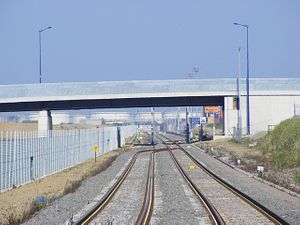On Monday, the first freight train from England to China left the station at Stanford-le-Hope, Essex, for Zhejiang province, China. The first train from China to England arrived in January, making London the 15th European city to have direct rail links with China.
The London-Yiwu train will travel nearly 7,500 miles over the course of 17 days, crossing over to France via the Channel Tunnel and winding through Belgium, Germany, Poland, Belarus, Russia, and Kazakhstan before crossing into China and ending its journey in the country’s east. At the Poland/Belarus and Kazakhstan/China borders the containers will need to be transhipped from trains running on standard gauge (1,435 mm) to Russian gauge (1,520 mm) and back. Despite this procedure, the rail route is widely touted as faster than shipping by sea and cheaper than shipping by air.
The loading of the final containers on April 10 was attended by an array of important guests: Vice Governor of Zhejiang province Liang Liming, the U.K. Prime Minister’s Business Ambassador for Infrastructure & Transport Rupert Soames, and Mayor of Yiwu Shi Wenzhen.
Greg Hands, minister of state in the Department for International Trade, praised the new rail link as demonstrating “the huge global demand for quality U.K. goods. “This new rail link with China is another boost for Global Britain, following the ancient Silk Road trade route to carry British products around the world,” he said.
Cargo on the eastbound train included soft drinks, vitamins, pharmaceuticals, baby products, and whisky, according to Railway Gazette. The earlier Yiwu-London train carried bags, clothes, and household goods.
“Britain,” Reuters reported, “is seeking to enhance its trade links with the rest of the world as it prepares to leave the EU in two years’ time.”
But the rail line is far more than a British accomplishment. DP World Group, the Dubai-based shipping magnate, is behind the development of the London Gateway — the deep-water port and logistics hub in Essex where the London-Yiwu line originates.
DP World Group Chairman & CEO, Sultan Ahmed Bin Sulayem told the audience gathered Monday that “London Gateway has joined the Silk Road.”
For China, the new London route is just another on the growing list of connections to European destinations — all part and parcel of the One Belt, One Road (OBOR).
According to Wade Shepard, there are 39 rail lines which connect 15 European cities to 16 different Chinese cities. While the two initiatives — one maritime, one land — that form what we now call the One Belt, One Road were not formally unveiled until 2013, efforts to link China to Europe via rail had already begun before Beijing co-opted existing projects and marketed the idea as a sweeping grand strategy.
Test runs between Chongqing, China and Duisburg, Germany began in 2011. In a 2011 article, Xinhua hailed the route as “offer[ing] a major shortcut to the more traditional sea trade routes from Shanghai and Guangzhou.” By 2012, trains left Chongqing at least once a month for Germany. In 2014, China heralded the beginning of regular service between the two cities, noting that since 2011, “A total of 110 customized trains, mostly loaded with electronic products, have traveled along the route so far.”
Other routes to Europe have popped up at an increasing rate in the subsequent years as the OBOR gained steam, both as a concept and as a strategy with the serious financial backing of Beijing. Existing projects clamor to become part of the new Silk Road and Chinese regions jockey to get a link.
When the first Chinese train arrived in London in January, DB Cargo — which handles the German and British portions of the trip — claimed that in 2016 “around 40,000 containers were transported by rail along the routes between China and Europe… with journey times of between 12 and 16 days.” Traffic is expected to reach 100,000 containers annually by 2020.

































